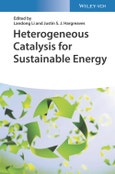Heterogeneous Catalysis for Sustainable Energy
Explore the state-of-the-art in heterogeneous catalysis
In Heterogeneous Catalysis for Sustainable Energy, a team of distinguished researchers delivers a comprehensive and cutting-edge treatment of recent advancements in energy-related catalytic reactions and processes in the field of heterogeneous catalysis. The book includes extensive coverage of the hydrogen economy, methane activation, methanol-to-hydrocarbons, carbon dioxide conversion, and biomass conversion.
The authors explore different aspects of the technology, like reaction mechanisms, catalyst synthesis, and the commercial status of the reactions. The book also includes: - A thorough introduction to the hydrogen economy, including hydrogen production, the reforming of oxygen-containing chemicals, and advances in Fischer-Tropsch Synthesis - Comprehensive explorations of methane activation, including steam and dry reforming of methane and methane activation over zeolite catalysts - Practical discussions of alkane activation, including cracking of hydrocarbons to light olefins and catalytic dehydrogenation of light alkanes - In-depth examinations of zeolite catalysis and carbon dioxide as C1 building block
Perfect for catalytic, physical, and surface chemists, Heterogeneous Catalysis for Sustainable Energy also belongs in the libraries of materials scientists with an interest in energy-related reactions and processes in the field of heterogeneous catalysis.
Explore the state-of-the-art in heterogeneous catalysis
In Heterogeneous Catalysis for Sustainable Energy, a team of distinguished researchers delivers a comprehensive and cutting-edge treatment of recent advancements in energy-related catalytic reactions and processes in the field of heterogeneous catalysis. The book includes extensive coverage of the hydrogen economy, methane activation, methanol-to-hydrocarbons, carbon dioxide conversion, and biomass conversion.
The authors explore different aspects of the technology, like reaction mechanisms, catalyst synthesis, and the commercial status of the reactions. The book also includes: - A thorough introduction to the hydrogen economy, including hydrogen production, the reforming of oxygen-containing chemicals, and advances in Fischer-Tropsch Synthesis - Comprehensive explorations of methane activation, including steam and dry reforming of methane and methane activation over zeolite catalysts - Practical discussions of alkane activation, including cracking of hydrocarbons to light olefins and catalytic dehydrogenation of light alkanes - In-depth examinations of zeolite catalysis and carbon dioxide as C1 building block
Perfect for catalytic, physical, and surface chemists, Heterogeneous Catalysis for Sustainable Energy also belongs in the libraries of materials scientists with an interest in energy-related reactions and processes in the field of heterogeneous catalysis.
Table of Contents
PART I: INTRODUCTIONChapter 1 Heterogeneous Catalysis in Face of Energy Challenges
PART II: HYDROGEN ECONOMY
Chapter 2 Water-gas Shift Reaction
Chapter 3 Reforming of Oxygenates
Chapter 4 The Fischer-Tropsch Synthesis
Chapter 5 Ammonia Synthesis
PART III: METHANE ACTIVATION
Chapter 6 Steam and Dry Reforming of Methane
Chapter 7 Oxidative Coupling and Dehydroaromatisation
Chapter 8 Selective Oxidation to C1 Oxygenates
Chapter 9 Halogenation and Oxy-halogenation
PART IV: ALKANE ACTIVATION
Chapter 10 Catalytic Cracking over Solid Acids
Chapter 11 Catalytic Dehydrogenation of Light Alkanes
Chapter 12 Selective Oxidation to Oxygenates
PART V: METHANOL-TO-HYDROCARBONS
Chapter 13 Zeolite Catalysts and Their Behaviors
Chapter 14 Reaction and Deactivation Mechanism
Chapter 15 Insights from Theoretical Calculations
Chapter 16 Commercial Status and Economics
PART VI: CARBON DIOXIDE AS C1 BUILDING BLOCK
Chapter 17 Overview on CO2 mission and Utilization
Chapter 18 Chemical Fixation into Carbonates
Chapter 19 Reduction to Methanol
PART VII: BIOMASS CONVERSION
Chapter 20 Catalytic Conversion of Triglycerides
Chapter 21 Catalytic Conversion of Glycerol
Chapter 22 Conversion of Carbohydrates and Their Derivatives
Chapter 23 Nitrogen Containing Platform Molecules to Chemicals
PART VIII: PROSPECT
Chapter 24 Summary and Outlook








